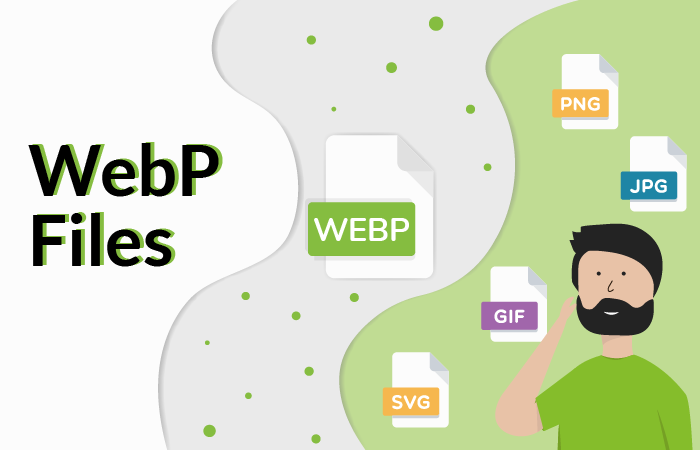WebP files - what are they and how to use them?
Updated: 15th September 2022
Reading time: 5 min
Recently, WebWave website builder introduced the automatic conversion of image files to the WebP format. In this post you will get to know the most important details about WebP files, learn about their benefits and how they differ from other image files.
What is the WebP format
WebP is a graphic file format created to replace older formats such as JPEG, PNG and GIF. It was developed by Google and based on the work of On2 Technologies, which was later bought out by a California giant.
WebP technology is designed to reduce the size of images. Its origins date back to September 2010, when the WebP format was introduced as a new open standard for graphic files. It uses lossy compression. As a result, the weight of the files compared to the JPEG format was reduced while maintaining comparable quality. Since 2012, the WebP format also supports lossless compression. It is therefore also an alternative to PNG.
WebP files and other file formats
WebP technology is to replace several popular file formats. How does it compare to them?
WebP files and JPEG
In this case, newer technology beats its predecessor. WebP files are 25-35% smaller compared to PNG. They maintain the same quality.
WebP files and PNG
According to many website creators, PNG is the second-best format after WebP. Both file types support transparency, which is especially important when designing websites. It gives you the freedom to use images on several layers of the site.
WebP files are 26% smaller while maintaining PNG quality. As a result, pages using the new format load faster.
WebP and GIF
In this case the newer format will not necessarily work better. Yes, WebP files are smaller while maintaining image quality. However, the APNG format will be the best solution here. It wins both in quality and size.
WebWave AI Writer
Generate your website copy with just one click.
WebWave AI Writer
Generate your website copy with just one click
Advantages of the WebP format
In the era of high resolution screens, the quality of graphics is of great importance. Images should look good on many types of devices - from small smartphones to laptops and desktop monitors, to large TV screens. Remember that graphic files constitute about 65% of the data on the page.
Website developers are therefore facing a real challenge. They must reconcile the high quality of graphics with the speed of loading.
The WebP format responds to such demand. As we have already mentioned, the basic advantage of WebP graphics is a favorable ratio of quality to file size. Thanks to this, the images are visually attractive on the one hand, and do not slow down the loading of the page on the other. Web developers no longer need to look for compromise solutions.
This is important for at least two reasons. First of all - it's about the convenience of users. The page that loads too long is unattractive from their perspective. That's why they probably leave it quickly. On the other hand, you can't compromise on quality. The graphics in low resolution do not look very interesting on modern screens. That's why WebP files are the perfect solution here.
The second aspect is Google indexing. Sites that load too long lose the chance to rank first in search results. Accelerating page loading by using the WebP format will make the algorithms of Moutain View giant rank it higher.
What about the disadvantages?
The biggest limitation for WebP files is the fact that it is not yet widespread. Chrome was the first search engine to support it. This should not come as a surprise considering that both solutions are provided by Google. Currently, WebP files are also supported by Opera.
Unfortunately, some of the most popular search engines still do not support the Webp format. These include Safari Internet Explorer and Firefox.
The situation is similar in the case of graphic programs. Therefore, in many cases it is necessary to convert WebP files to older formats.
In the era of high-resolution screens, the quality of graphics is of great importance - Images should look good on many types of devices
Converting WebP files
Fortunately, this task is not complicated. There's a couple of methods that can be applied here. Here are 3 easiest.
Use a different browser
As we have already mentioned, some browsers do not support WebP technology. That is why we will find graphics in older formats by entering the site using one of them. Sometimes, all you have to do is open the page in Safari or Internet Explorer and download the graphics you are interested in.
Use MS Paint
If you are using Windows 10, you can save the file to your hard disk and then open it in Paint. Hover over the downloaded file, then right-click, expand the Open list and select Paint. In the top menu click File and select Save as. Now you can save the image in the selected format.
Use an online converter
On the internet you will find many tools to convert WebP files. Most often, you just have to drag the file and place it in the right place on the page and the conversion will start automatically.
Conclusion on WebP files
WebP is becoming the standard in web design. You should undoubtedly apply this technology to your website. This will increase the speed of loading the site. It will become more user-friendly and Google robots will place it higher in search results.
In the WebWave website builder you create a site with WebP files. What's more, the images on the page are automatically converted to this format when the page is published. So let's use our tool and keep up to date with trends.
Author: Jan Chmielowski
Other articles.
Company.
Help.
Templates.
